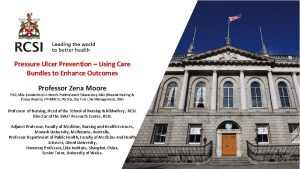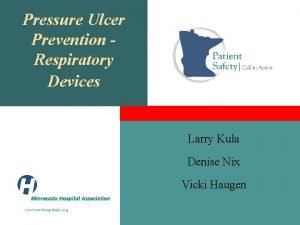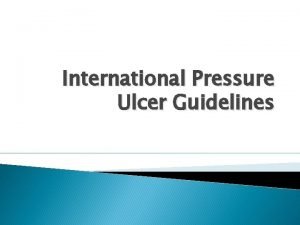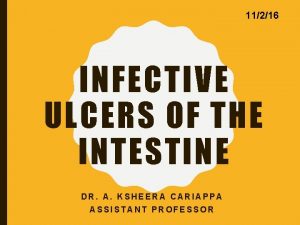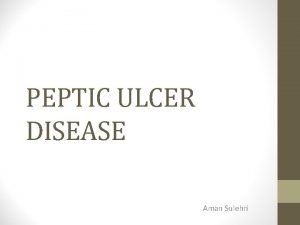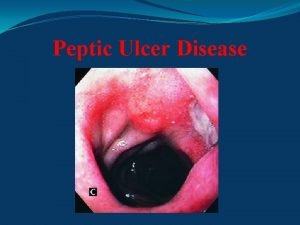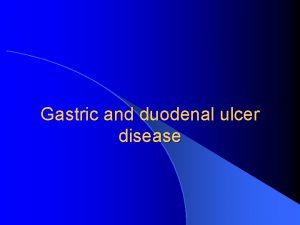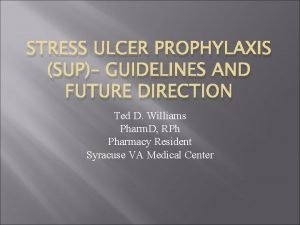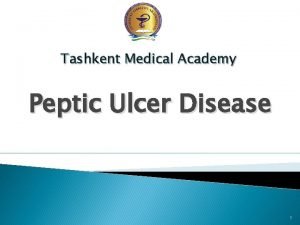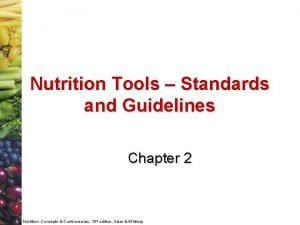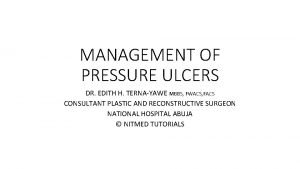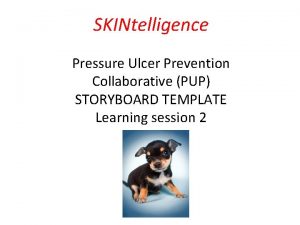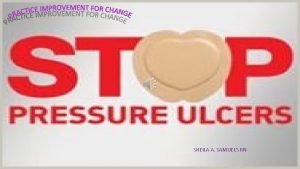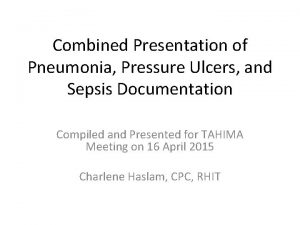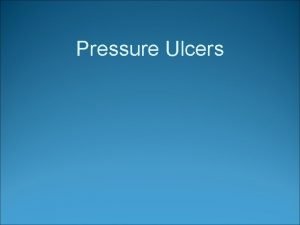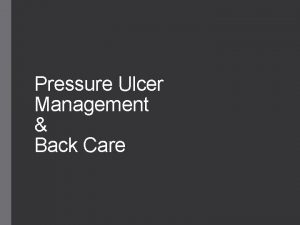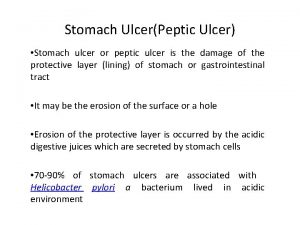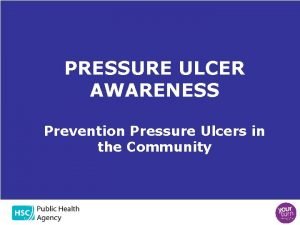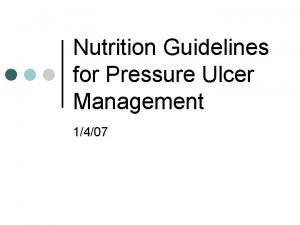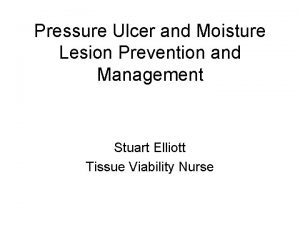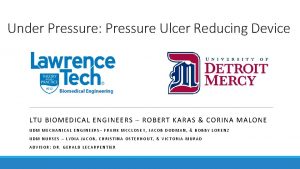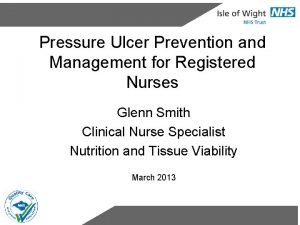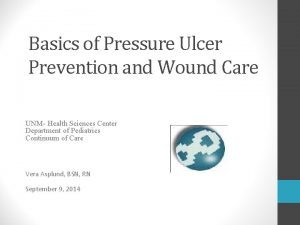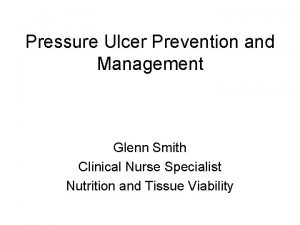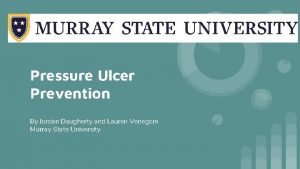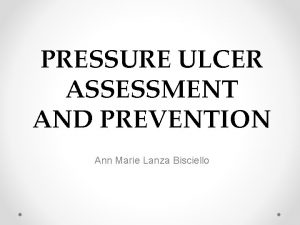Nutrition Guidelines for Pressure Ulcer Prevention and Treatment

















- Slides: 17

Nutrition Guidelines for Pressure Ulcer Prevention and Treatment: Featuring the 2014 NPUAP/EPUAP/PPPIA International Guidelines Review the 2014 National Pressure Ulcer Advisory Panel, European Pressure Ulcer Advisory Panel and Pan Pacific Pressure Injury Alliance (NPUAP‐EPUAP‐PPPIA) Nutrition Guidelines for Pressure Ulcer Prevention and Treatment

Objectives Implement the nutrition screening and assessment process to determine malnutrition risk; and apply the nutrition care process. Provide some practical solutions for nutrition and hydration for prevention and treatment of pressure ulcers.

Risk Factors of pressure ulcer undernutrition, Protein-Energy Malnutrition (PEM) and dehydration are known risk factors for pressure ulcer development malnutrition and /or weight loss correlated with a fourfold higher risk of the development of pressure ulcers Need to quickly identify and treat undernutrition especially when pressure ulcers are present.

Malnutrition risk Monitor intake and weight Usual criteria should be considered: Intake consistently less than 75% Nausea, vomiting, diarrhea Metabolically stressed state - trauma, fever Significant weight loss (non fluid related): 1% in 1 week 5% in 1 month 7. 5% in 3 months 10% in 6 months

Nutrition Goals • Maintain current intake of nutrition • Achieve and maintain desirable weight • Routine Follow Up: • Assessment of: Weight Intake Pre-albumin Changes in condition

Energy Intake (Guidelines) Energy is essential for pressure ulcer healing Need to provide adequate calories To promote anabolism, nitrogen and collagen synthesis

Energy Intake (Guidelines) 1. Provide individualized energy intake based on underlying medical condition and level of activity. 2. Provide 30 to 35 (25 -30) kcalories/kg body weight for adults at risk of a pressure ulcer who are assessed as being at risk of malnutrition. 3. Provide 30 to 35 kcalories/kg body weight for adults with a pressure ulcer who are assessed as being at risk of malnutrition. 4. Offer fortified foods and/or high calorie, high protein oral nutritional supplements between meals if nutritional requirements cannot be achieved by dietary intake. 5. Consider nutritional support (enteral or parenteral nutrition) when oral intake is inadequate.

Protein: What Does the Evidence Suggest? All stages require adequate protein. Increased protein levels have been linked to improved healing rates. Protein intake must be sufficient to prevent PEM, promote healing and a positive nitrogen balance.

Protein Intake (Guidelines) 1. Provide adequate protein for positive nitrogen balance for adults assessed to be at risk of a pressure ulcer. 2. Offer 1. 25 to 1. 5 (1. 25) grams protein/kg body weight daily for an adult at risk of a pressure ulcer who is assessed to be at risk of malnutrition when compatible with goals of care, and reassess as condition changes. 3. Offer 1. 25 to 1. 5 grams protein/kg body weight daily for adults with an existing pressure ulcer who is assessed to be at risk of malnutrition. Stage 1 & 2 Pressure Ulcer 1. 25 -1. 5 gm/pro/kg/d Stage 3 & 4 Pressure Ulcer 1. 5 – 2. 0 gm/pro/kg/d

Protein Intake (Guidelines) 4. Offer high calorie, high protein nutritional supplements in addition to the usual diet to adults with nutritional risk and pressure ulcer risk, if nutritional requirements cannot be achieved by dietary intake. 5. Assess renal function to ensure that high levels of protein are appropriate for the individual.

Hydration (Guidelines) 1. provide and encourage adequate daily fluid intake for hydration for an individual assessed to be at risk of or with a pressure ulcer. This must be consistent with the individual’s comorbid conditions and goals. 2. Monitor individuals for dehydration: changes in weight, skin turgor, urine output, elevated serum sodium and/or calculated serum osmolality. 3. Provide additional fluid for individuals with dehydration, elevated temp, vomiting, profuse sweating, diarrhea or heavily draining wounds. 1 m. L/calorie consumed 30 -35 m. L/kg BW/day Needs may decrease for CHF, renal failure.

Vitamins and Minerals (Guidelines) 1. Provide/encourage individuals assessed to be at risk of or with pressure ulcers to consume a balanced diet that includes good sources of vitamins and minerals. 2. Provide/encourage an individual assessed to be at risk of / with a pressure ulcer to take vitamin and mineral supplements when dietary intake is poor or deficiencies are confirmed or suspected.

Vitamin C Increases immunity Increase collagen synthesis There is no support for vitamin C above the DRI unless a deficiency is diagnosed or suspected. If deficiency is diagnosed or suspected, vitamin C supplement is recommended

Zinc Positive effect of zinc supplementation on improved pressure ulcer healing when there is deficiency. When clinical signs of zinc deficiency are present, zinc should be supplemented at <40 mg elemental zinc/day Doses >40 mg/day can adversely affect copper status and possibly result in anemia. 25 mg zinc along with 2 mg of Cu for 2 weeks or less High serum zinc levels may inhibit healing

Conditionally Essential Amino Acids Arginine: Wound Healing (via IGF 1) Required for collagen synthesis (precursor to polyamines) Increased in collagen deposition in wound bed with 15 g of arg/d Average dietary intake 7. 5 g arg/day Increased blood flow (Nitric Oxide Pathway) Stage 1 & 2 Pressure Ulcers: 7 -15 gm/d arginine Stage 3 & 4 Pressure Ulcers : 10 – 20 gm/d arginine

Conditionally Essential Amino Acids Glutamine Regulates protein turnover Stores depleted at 10 – 15% loss of lean body mass Immunity Preferred fuel source for lymphocytes & enterocytes N-Acetyl Cysteine + Glutamine = Glutathione which leads to decreased oxidative stress GI Function & Immunity Restores gut integrity & brush boarder which improves absorption & appetite (20 g gln/d) Precursor for nucleotides Helps maintain Acid base balance, Ammonia production

 Primary prevention secondary prevention tertiary prevention
Primary prevention secondary prevention tertiary prevention Pressure ulcer prevention bundle
Pressure ulcer prevention bundle Nasal cannula pressure ulcer prevention
Nasal cannula pressure ulcer prevention Depuap
Depuap Niche on lesser curvature
Niche on lesser curvature Tuberculous ulcer vs typhoid ulcer
Tuberculous ulcer vs typhoid ulcer Ulcer niche and ulcer notch
Ulcer niche and ulcer notch Duodenal ulcer vs gastric ulcer
Duodenal ulcer vs gastric ulcer Triple therapy for peptic ulcer disease
Triple therapy for peptic ulcer disease Billroth ii anatomy
Billroth ii anatomy Stress ulcer prophylaxis guidelines
Stress ulcer prophylaxis guidelines Mendel sign peptic ulcer
Mendel sign peptic ulcer Healthypeopleenergy
Healthypeopleenergy Nutrition tools standards and guidelines
Nutrition tools standards and guidelines Ischial pressure ulcer location
Ischial pressure ulcer location Pressure ulcer safety cross template
Pressure ulcer safety cross template Pressure ulcer pico question
Pressure ulcer pico question Braden scale for predicting pressure sore risk
Braden scale for predicting pressure sore risk

